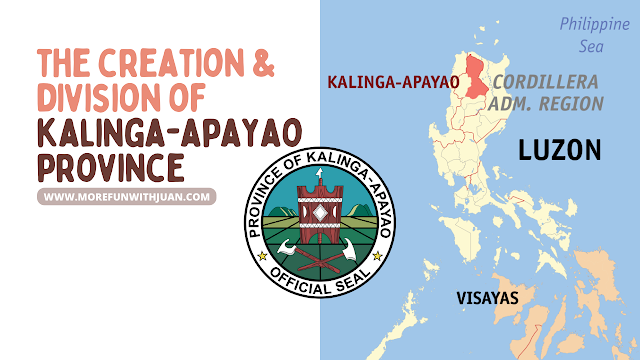Kalinga-Apayao (IPA: [kaliŋɡa apajaw]) was a province of the Philippines in the Cordillera Administrative Region in the island of Luzon. It was formed, along with Benguet, Ifugao, and the new Mountain Province, from the earlier Mountain Province, with the passage of Republic Act No. 4695 in 1966. The said law was amended by RA No. 7878 in 1995, which divided the province into two new ones, Kalinga and Apayao.
Loading...
 |
| Kalinga-Apayao on Philippine Map |
The Creation of Kalinga-Apayao Province
Prior to the establishment of the province, the sub-provinces of Kalinga and Apayao, upon their establishment through Act No. 1642 in 1907, were used to be part of Lepanto-Bontoc (as Kalinga was taken from Cagayan and Isabela) and Cagayan provinces respectively. The sub-provinces were annexed into the Mountain Province which was established through Act No. 1876 in 1908.
In the early years, the sub-provinces underwent series of territorial changes:
- Part of Kalinga was transferred to another sub-province Bontoc (Executive Order 53, 1914); same as part of Apayao to the province of Ilocos Norte (EO 21, 1920).
- 1922: In Apayao, a barrio of municipal district of Bayag (Calanasan) to Namaltugan.
- 1926: In Kalinga, barrios in municipal district of Pinukpuk to Balbalan.
- 1927: Parts of the municipal district of Pinukpuk in Kalinga to Conner in Apayao.
 |
| Kalinga-Apayao Seal |
Since the creation of the sub-provinces, Tabuc (Tabuk) was designated as the capital of Kalinga. In Apayao, its first sub-provincial capital was Tauit until mid-1915, when it was moved to Kabugao via EO 45.
The Division of Kalinga-Apayao Province
By virtue of RA 7878, signed on February 14, 1995, the sub-provinces in Kalinga-Apayao were converted into two new provinces, Kalinga and Apayao, with their capitals remain the same as before. Both comprises the same municipalities that were used to be part of these sub-provinces.
Majority of voters in Kalinga-Apayao ratified the said law in a plebiscite on May 8.
Administrative Divisions
Municipalities in Kalinga and Apayao sub-provinces before 1995:
ATTRACTIONS TO SEE IN MANILA
Klook.comBy the time Kalinga-Apayao was established, eight municipalities remained part of the subprovince of Kalinga, six municipalities in the Subprovince of Apayao as well.
Within almost three decades, two new municipalities were later created. On the same day of the creation of the province, Pasil in Kalinga was created (RA 4741); also, Santa Marcela in Apayao in 1967 (RA 4974).
Meanwhile, the municipality of Quirino in Kalinga, which had established before, was abolished sometime between 1975 and 1980. Before the division in 1995, the province had 15 municipalities and 283 barangays.
ACTIVITIES AND TOURS IN MANILA
Kalinga-Apayao map Feedback kalinga apayao from manila kalinga apayao location kalinga philippines kalinga province kalinga apayao tourist spot kalinga apayao pronunciation kalinga apayao language
















No comments
Let us know your thoughts!